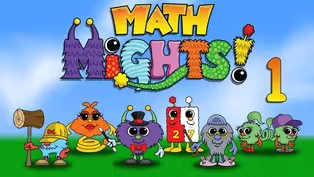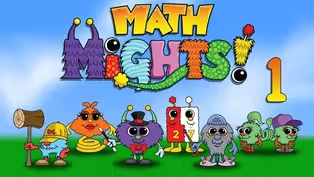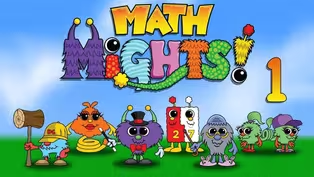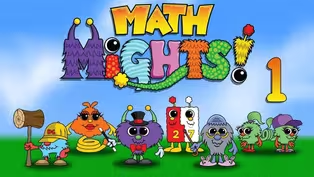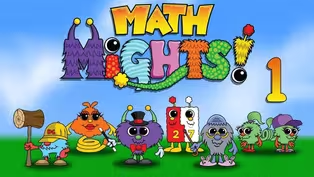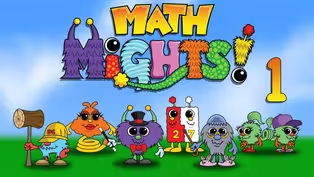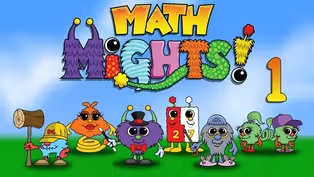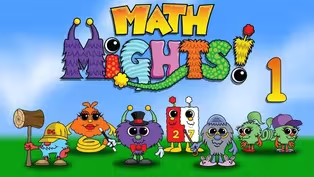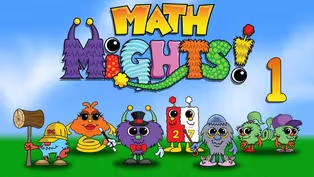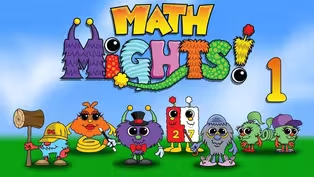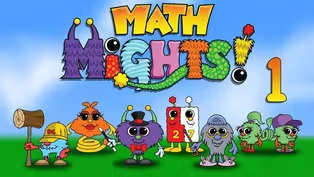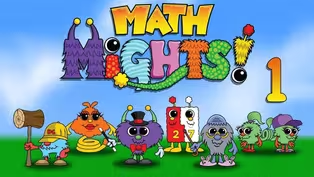Math Mights
Make Sense of Equations
Season 3 Episode 307 | 15m 59sVideo has Closed Captions
Join Mrs. Markavich for a subtraction word problem with Professor Barble.
Join Mrs. Markavich for a subtraction word problem with Professor Barble. Next get ready make sense of equations that have a missing part and look out for D.C. as we make a ten to solve addition easier!
Problems playing video? | Closed Captioning Feedback
Problems playing video? | Closed Captioning Feedback
Math Mights is a local public television program presented by Detroit PBS
Math Mights
Make Sense of Equations
Season 3 Episode 307 | 15m 59sVideo has Closed Captions
Join Mrs. Markavich for a subtraction word problem with Professor Barble. Next get ready make sense of equations that have a missing part and look out for D.C. as we make a ten to solve addition easier!
Problems playing video? | Closed Captioning Feedback
How to Watch Math Mights
Math Mights is available to stream on pbs.org and the free PBS App, available on iPhone, Apple TV, Android TV, Android smartphones, Amazon Fire TV, Amazon Fire Tablet, Roku, Samsung Smart TV, and Vizio.
Providing Support for PBS.org
Learn Moreabout PBS online sponsorshipMore from This Collection
Video has Closed Captions
Join Mrs. Markavich for a missing addend word problem with Professor Barble! (16m 5s)
Adding Tens-Tens and Ones-Ones
Video has Closed Captions
Join Mrs. Markavich for a missing addend word problem with Professor Barble! (15m 35s)
Write Equations to Match the Strategy
Video has Closed Captions
Join Mrs. Markavich for a missing addend word problem with Professor Barble. (16m 2s)
Video has Closed Captions
Join Mrs. Markavich for a missing addend word problem. (16m 6s)
Add 2-Digit Numbers & Write Equations
Video has Closed Captions
Join Mrs. Markavich for a word problem with her friend Professor Barble! (15m 59s)
Comparing Numbers Different Ways
Video has Closed Captions
Value Pak shows you the different ways to compare 2-digit numbers. (15m 44s)
Video has Closed Captions
Join Mrs. Markavich for a word problem with her friend Professor Barble! (15m 59s)
Video has Closed Captions
Join Mrs. Markavich for a word problem with her friend Professor Barble! (15m 59s)
Decompose/Compose #'s Different Ways
Video has Closed Captions
We show you different ways to decompose and compose 2-digit numbers! (15m 59s)
Video has Closed Captions
Join Mrs. Markavich & Dotson to talk about numbers with the Counting Buddy Senior! (16m)
Video has Closed Captions
Join Mrs. Markavich & Dotson for a Numeracy Talk with the Counting Buddy Senior (16m)
Video has Closed Captions
Join Mrs. Markavich for Numeracy Talk with Dotson working on conservation to 20. (16m)
Providing Support for PBS.org
Learn Moreabout PBS online sponsorship(peppy music) - [Kids] Math Mights!
- Welcome 1st Grade Math Mights.
I'm Mrs. Markovich, and I'm so excited that you're here with me today.
Let's check out our plan for today.
Today, we'll conquer a word problem with my friend, Professor Barble.
Then, we'll make sense of equations.
Let's warm up our math brain with my friend Professor Barble, as he conquers word problems.
Hey professor barbel come on over.
(peppy music) Professor Barble is a math might from MathVille and he loves to solve word problems.
And if he slows down to think about what the problem is asking and he presses on his thinking cap outcome some really cool tools that will help him create a picture in his mind of what the problem is asking.
You might ask yourself what is a visual model?
Sometimes it is known as a model drawing unit bar, tape diagram or bar model.
Drawing a visual model helps to visualize the strategies and understand what the word problem is asking.
It is also a reading comprehension strategy for word problems.
Let's look at our template that we're using today.
This is something we use in first grade.
It will help us with the visual model.
Let's read our problem for today.
It says there were 16 coats on the rack.
Nine students took their coats to go outside.
How many coats are still on the rack?
Well, my friend Rosa says, "I think maybe we should add to solve the problem."
Gracie says, "Oh wait, do we subtract?"
Professor Barble says, "Hold on a minute, I think we need to slow down to see what the problem is really asking."
He doesn't want us to guess, do we need to add or subtract?
He wants us to use a step-by-step visual model process to create a picture of what the problem is asking.
The first step is to read the entire problem and put it in chunks.
Let's do that together.
I'm going to say it and chunk it and you're going to echo me.
Let's give it a try.
There were 16 coats on the rack.
Chunk.
Nine of the students took their coats to go outside.
Chunk!
And the last part says, how many coats are still on the rack?
Chunk!
Step two, we rewrite the question in a sentence form with a blank space for the answer.
We do this so we know what we are solving for.
You can take a look at mine.
It says this, there are hmm, hmm, still on the rack.
Our next step is to determine the who or what is in the problem.
When you look at mine you can see that the who or what is coats.
The next step is to draw our unit bar.
And on mine, you can see I've done it for you right here.
I haven't put in the spaces for us this time.
We're going to do that together.
Step five, we're going to put checks as we add in our chunks.
The first thing that we're going to do is say, there were 16 coats on the rack.
I know that 16 is the whole number.
So I'm gonna add that at the end, like this.
I'm gonna put a line and put 16 then I'm gonna go back and check that off.
The next part says nine students took their coats to go outside.
I'm going to add that into my unit bar and I'm going to make sure that I draw that line in there to show that part, like this.
And I'm going to put in nine and then I'm going to label it with an O for outside.
I'm going to go back up and make sure that I check that off.
The next part says, how many coats are still on the rack?
Hmm!
How many coats are still on the rack?
That means I need to put an R right here for the coats that are still on the rack.
And I need to add a question mark because that's the part that I don't know.
I'm gonna put a question mark right here and I'm going to go back up and check that part off.
Just like that.
Before we move on to our next step there's one more thing we need to do.
We know that nine students took their coats to go outside.
So we're going to go into our unit bar and we're going to put a slash in here.
That'll tell us that there were nine coats that went outside, just like this.
Our next step is to correctly compute our problem.
We use the word compute to figure out the answer.
My friend says, I know we need to subtract to solve this problem.
Let's do that together, it looks like this.
16 minus nine equals hmm.
And you might be wondering, well how should I solve this?
I know, I think I could make 16 of something and cross off the nine just like we did in my unit bar.
Let's try it.
Let's make 16 circles.
Now I'm going to take nine away or cross nine off.
Let's do that together.
One, two, three, four, five, six, seven, eight, nine.
And I know that I have one, two, three, four, five, six, seven left.
I'm going to put the seven right here.
We have one more really important step that we need to do.
Step number seven is to write our answer back in our sentence form.
Let's do that together on mine.
Let's look here.
It says, there are hmm, hmm still on the rack.
There are hmm, well, I know there are seven of something on the rack.
Let's add in our seven.
Let's go back to our who or what, which was coats.
I know there are seven coats still on the rack.
Let's write the word coats on that line.
Boy Professor Barble sure would be proud of us today solving a word problem with the visual model.
Let's head over and check out our I CAN statement of the day says.
Our I CAN statement of the day says, "I can add one digit and two digit numbers and make sense of equations."
Let's take a look at these 10 frames and this equation.
It says 45 plus hmm equals 50.
What value makes this equation true?
How many to the next ten?
Hmm, I use the 10 frames to see what was missing.
I wonder if you did the same thing.
Let's see what my friend Gracie thought.
Gracie says five.
I see four tens and five ones and five more would fill up the 10 frame.
Were you thinking the same thing?
Let's take a look on my board and solve that together.
So what you can see based on what Gracie said is, she saw four tens, one, two, three, four, or you could count by tens, 10, 20, 30, 40.
And she said she saw five ones right here.
And then she said, she knew that five more would make 50.
You can see that right here.
She knows that she needs five more to make 50.
I'm gonna show you that with some yellow counters.
It looks like this one, two, three, four, five.
Gracie made that picture in her mind of a 10 frame and she knew that five more would make 50.
So then we would put 45 plus five equals 50.
I'm gonna write that five and for you.
Great thinking, Gracie.
Let's take a look at another one.
38 plus hmm equals 40.
What do you need to get to the next 10?
Let's look at mine and solve it together.
Here we go.
I have 10, 20, 30, 31, 32, 33, 34, 35, 36, 37 38.
Look at that.
10.
What do you see that is missing?
How many more do you need?
I think I see two empty spaces or two less than 10.
So I need to add two here, just like this.
One, two.
So I know I need two more to get to 40.
I'm going to add a two in my box like this, and I know 38 plus two equals 40.
Great job using 10 frames to visualize what value you would need next boys and girls kiss your brains, chuik.
Rosa is going to solve this problem.
34 plus nine equals hmm.
She started with 34 plus six equals 40.
What did you notice about her first step?
Hmm, I wonder if I should call on my friend DC to help us out.
(peppy music) Hey DC!
DC is one of my math might friends that lives in MathVille.
And DC is a perfectionist.
He likes things a certain way.
He wears a hard hat and carries a mallet.
DC likes friendly numbers or numbers that make a 10.
And if those numbers don't make a 10, he uses that mallet to smash those numbers or decompose them into numbers that he wants, like this.
We have 34 plus nine.
Watch my friend DC decompose this number.
(loud bang) Now you can see that DC decompose the number into, six and three.
So this is how I think my friend Rosa got the six.
Let's work it out together on mine.
You can see here that I have 10, 20, 30, 31, 32, 33, 34.
And right here, I have a 34, but DC says, no thank you.
I want this a different way.
And I'm going to decompose my nine that are here.
I'm gonna move these up here.
One, two, three, four, five, six.
Now, can you see, I have six to fill in this 10 frame and then I have three here, just like Rosa did that looks like this, when I decompose the nine.
I put a six here and a three here.
Now this makes it easier for me to add because DC likes those friendly numbers.
I have 34 and six which makes 40 plus the other three, one, two three right here gives me 43.
Thanks DC for helping us solve that.
And thanks, Rosa for doing such a great job.
DC did such a great job helping us with our last problem.
Let's try another one with him.
This time our problem says six plus 68.
Hmm, I wonder how he's going to decompose it this time.
Do you think he'll decompose the six or the 68?
I think we should take a look.
Hey DC, help us decompose this number.
(loud bang) You can see he chose to decompose the six into a four and two.
I think we need to take a closer look at it on mine.
Let's head over to my model.
I have an abacus here with me today.
We're going to use the abacus to show how DC decomposed the six.
Let's start with our whole number of 68.
It looks like this, 10, because remember these are in groups of 10.
10, 20, 30, 40, 50, 60, 61, 62, 63, 64, 65, 66, 67, 68.
Now I have six.
One, two, three, four, five, six.
I'm gonna leave this six right here and we're going to walk through this together.
I saw that DC decomposed my six into a four and two.
Remember DC likes things a certain way and he wants to make a 10.
So he decomposes the six into four and two.
Can you see that I have two more right here?
So he's going to smash this into four and two.
We're gonna slide those two over to make a 10 and move these here.
And now I have 10, 20, 30, 40, 50, 60, 70, 71, 72, 73, 74.
I'm going to combine these two because remember DC likes a 10.
This gives me 70 plus the four.
And I know that four plus 70 equals 74.
That was a lot of work but a great way to decompose the number and have DC help us along the way.
Thanks so much DC and great work boys and girls.
All right, friends.
Now it's time for us to play a game.
My game is called, Closest to 95.
In this game we're going to start with a number and then we're going to draw a card.
We're going to try to get closest to the number 95 without going over.
Let's give it a try.
I have 55 plus hmm equals hmm.
I want to be player one.
I drew the number six.
I'm going to put a six right here.
55 plus six equals hmm.
I think I'm gonna use my friend DC to decompose the six and make a friendly number.
That way it'll be easier for me to add.
So I'm going to decompose my six into five and one.
I know that 55 and five more gives me 60 plus one which would give me an answer of 61.
And I can keep playing until I get close to 95 without going over.
Now it's your turn to play closest to 95 with a friend.
Boys and girls I had so much fun with you today.
We solved a word problem with my friend Professor Barble, using the step-by-step visual model process and we used DC to help us make sense of equations.
That was a lot of work.
Your brain must be really tired.
So make sure you give it a kiss, chuik.
(peppy music) (soft piano music) - [Announcer] Sis4teachers.org.
Changing the way you think about math.
- [Instructor] This program is made possible with funding from the Michigan Department of Education.
Governor's Education Emergency Funds.
The state of Michigan, and by viewers like you.
(soft piano music)


- Home and How To

Hit the road in a classic car for a tour through Great Britain with two antiques experts.










Careers that Work

Support for PBS provided by:
Math Mights is a local public television program presented by Detroit PBS
